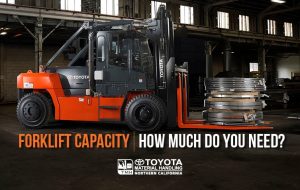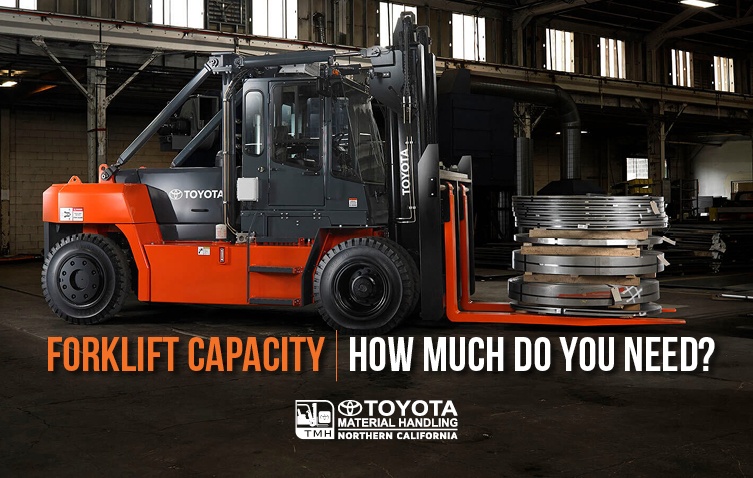Determining Your Forklift Carrying Capacity

Image courtesy of Toyota Forklift – Bahrns ToyotaLift is an award-winning Toyota Forklift Dealership
All forklifts are required by law to have clearly legible data plates attached to them listing their carrying capacity. At the very least, the plates should include information about the mast height, the load center, and the lifting capacity using forks alone. However, this carrying capacity is based on using the forks under optimal safety conditions.
A standard forklift’s carrying capacity is based on a 48″X48″ pallet load of materials. The pallet will be positioned at the back of the forks and the mast returned to the upright position. When materials are carried on the lift truck, the forks should be lowered to near ground level. If these basic rules are followed and the forklift is driven at a slow speed on a level surface, it can safely handle a capacity load. However, any alterations that can affect forklift stability will reduce its carrying capacity.

The difference between 4000 lbs and 2666 lbs is a big difference.
It’s not always possible to carry loads under optimal safety conditions, but if you know your forklift’s capacity limitations, you can still safely handle materials. The image here shows the difference in the capacity of a forklift that has a rated capacity of 4000 pounds when the load’s center of gravity is shifted forward just 12 inches. The same forklift that can carry a 48″X48″ 4000-pound load can only carry 2666 pounds if the load is 6 feet long. That difference of 1334 pounds is a big difference. How did they figure out the difference?
Fortunately, you don’t need to go back to college to figure out the carrying capacity of an evenly distributed load that has a load center greater than 24 inches. A couple of simple calculations are all that’s necessary:
1. Divide the load center as stated on the data plate by the actual load center (in the example above, that would be 24/36=.6666).
2. Multiply this result by the rated load capacity (4000X.6666=2666.6).
The increase in a load’s center of balance corresponds to something called the “load moment.” The load moment is calculated by multiplying the weight of the load by the distance of the load center. This yields a number called “inch-pounds.” Using the example above, 24X4000lbs=9600 inch-pounds. If the number of inch-pounds is exceeded, you are exceeding the forklift’s safe carrying capacity. The only way to make the load safe is to either decrease its weight or decrease its weight center until its load moment is equal to or less than 9600 inch-pounds.
Operator negligence is the primary cause of forklift accidents. A used forklift is just as safe as a new lift truck if it is used by a competent, alert operator. If you need a used forklift, you can find it at reconditionedforklifts.com. If you need training materials for your forklift operators, check out the OSHA materials cited above or go to our sister site, forkliftaccessories.com and check out the range of Forklift Training Materials available there. Together, a good used forklift and a well-trained operator equal a productive and profitable business.

